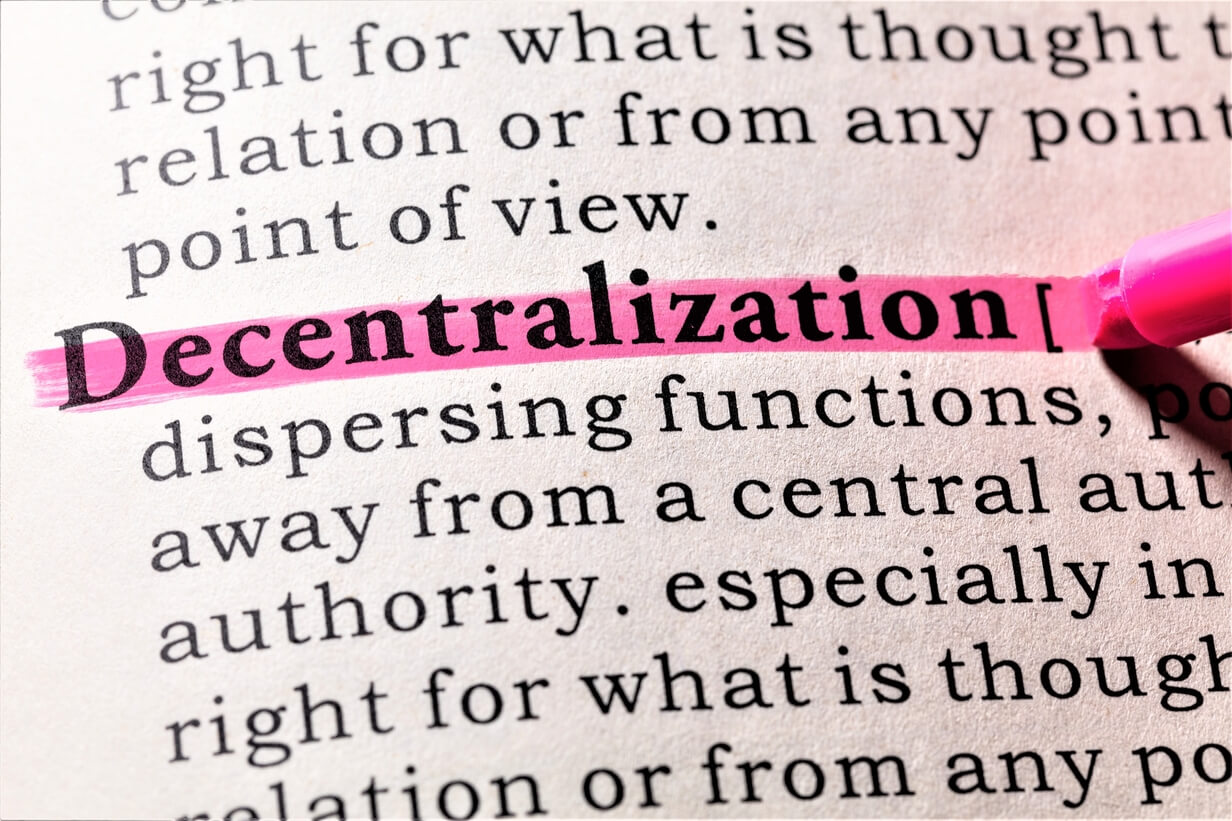Decentralization in Crypto Is a Hard to Measure Ideal

- Decentralization is a technical inability for any one party to perform major changes in the system.
- There are other metrics of decentralization, like the distribution of wealth in a system.
- There are different forms of centralization which extend to products and services.
Cryptocurrency and decentralization are almost synonymous, yet few people in crypto agree on what it exactly means to be decentralized. Definitions vary widely from one person or organization to another, while views on just how much decentralization is desirable or optimal also differ significantly.
While most figures within the crypto industry share overlapping conceptions as to what decentralization essentially is on a technical level, they tend to disagree as to whether it’s possible to measure or quantify such decentralization. Some industry players speaking with Cryptonews.com hold that decentralization is more of a binary property than one with measurable dimensions, while others suggest that a number of more subjective elements — such as community participation — contribute towards decentralization.
More fundamentally, it also appears that ‘decentralization’ functions within crypto as a regulatory ideal or concept, one towards which platforms and projects aim in order to make themselves less centralized over time. The flipside of this is that centralization, while not always being desirable, may be a necessary launchpad and base from which decentralization evolves.
Defining decentralization
On a more technical level, the definition of decentralization isn’t too complicated.
“I would define decentralization as a technical inability for any one party to perform major changes in the system. In a decentralized system, it’s impossible to change the critical parameters such as monetary policy,” said Trezor Brand Ambassador Josef Tětek.
For Tětek, this means there isn’t really any decentralized cryptocurrency other than Bitcoin (BTC).
“If your favorite cryptocurrency undergoes hard forks regularly and promotes the ability to overhaul its monetary policy, it’s not decentralized,” he added.
Ethereum (ETH)-focused ConsenSys’ Lex Sokolin would most likely disagree that Bitcoin is the only decentralized cryptocurrency. That said, he shares the view that decentralization relates to the inability of any one party to wield disproportionate power over — or to threaten the security of — a platform.
“The base layer for blockchain-based systems requires very high security. It operates under the assumption that all the actors are trying to sabotage its core operations, and then tweaks the game theory of economic rewards such that even in that Hobbesian environment, the computation is true,” he told Cryptonews.com.
Sokolin explains that this is the characteristic of being “trustless”, where a blockchain isn’t relying on some trust provider to tell it what is and isn’t true.
“Anyone can rely on the data and software without having licenses, grants, or other delegation of powers. Decentralization in part refers to having many different participants run validators, or miners, or perform staking activities, which in turn contribute to these core attributes of security,” he said.
According to Sokolin, the more actors participating in securing the network, the more secure the network. Of course, he acknowledges that a number of factors — as well as differing aims — complicate this picture.
“There are other metrics of decentralization, like the distribution of wealth in a system. That tends to follow the regular patterns in human economies, with the 80-20 rule and power laws,” he said.
Even with this acknowledgment, Sokolin affirms that such outcomes are “separate from whether the underlying system is actually coherent and can perform its function without being hijacked.”
Some other industry players would appear to share this view. Nonetheless, some have different conceptions of decentralizations, while others emphasize the fact that there are different metrics and dimensions of decentralization.
“Decentralization is a spectrum and process in evolution, which is backed by separate blockchain networks and crypto protocols. Such consensus algorithms and tokenomic designs both shape the level of decentralization and allow direct transactions to take place without the need for an intermediary,” said OKEx CEO Jay Hao.
At the same time, different aspects of a platform can exhibit different degrees of decentralization (or centralization for that matter), according to Swarm Markets co-founder Philipp Pieper.
“There are different forms of centralization which extend to products and services as well as governance and consensus mechanisms,” he told Cryptonews.com.
Pieper suggests that, in the particular case of DeFi, all projects will have a degree of centralization, at least at some level of their operations. “For example, data oracles require some form of external input and present an opportunity for hackers to gain access to a platform,” he explained.
Can you measure how decentralized a platform is?
The fact that platforms are composed of different parts which exhibit different degrees of decentralization highlights just how tricky it would be to measure decentralization in any objective or non-controversial way.
“I don’t think there is a measurable degree of decentralization. I believe decentralization is binary: either there is some sort of leader figure or team (usually with a major premine), or there isn’t and it’s the node operators who ultimately decide,” said Josef Tětek.
Elaborating on this idea of decentralization being a binary property, Tětek explains that a decentralized system is one without any pre-mine or presale and with the ability to run full nodes on commercially available hardware and average bandwidth.
“Foundations, premines, or nodes requiring data center infrastructure are not compatible with a decentralized monetary system,” he said.
Likewise, Jay Hao argues that, instead of measuring or quantifying decentralization, we should pursue better ways of considering decentralization, such as looking at the community contribution involved.
“A classic example is Loot NFT, which took on a bottom-up approach, unleashing the power of crowdsourcing. The project originated from open-source transactions on a smart contract platform, and is now being developed and pushed forward with the community,” he said.
Hao added that he appreciates the vision of transforming a group chat into a community.
“I think this is something we should start looking into. Looking ahead, there could be decentralized autonomous governance in the future to authenticate the process,” he noted.
The ‘ideal’ degree of decentralization
Given that decentralization may not be directly measurable, the question of deciding on an ‘ideal’ amount of decentralization also becomes a fraught matter.
For Jay Hao, the reason why this is a difficult question to answer is that the optimal amount of decentralization is heavily dependent on the platform in question, and on the goals of its community.
“Based on the scale of the ecosystem, like Ethereum and many others, conversations happen and sparks ignite. Nothing is healthy going to extremes, while centralization and decentralization should be mutually beneficial and strike a balance; hence, we see more discussions around this topic happening recently,” he said.
Too much decentralization may also be undesirable, in that too much decentralization may impose certain negatives on a platform, such as a decline in security or scalability.
“With the level of decentralization, scalability and security issues remain. Among different blockchains, given the growing maturity of [layer 1] and [layer 2] markets, the market seems to be moving forward towards a new era about network effects, and also applications come first rather than looking at the nature of decentralization,” Hao said.
On the other hand, Josef Tětek doesn’t think there can be ‘too much’ decentralization, since in his view a platform is either decentralized or it isn’t.
“Since I don’t believe decentralization is a spectrum, I also don’t think there is any tipping point in decentralization. But there definitely is a path dependence: centralized cryptocurrencies will never become decentralized,” he said.
While blockchains may be fundamentally decentralized (or not), some industry participants hold that some centralization, at least in certain areas, may be desirable for certain platforms. And at the very least, some users may prefer an efficient centralized system to one that’s decentralized but has certain usability issues.
He says, “Centralization is not a negative thing for the crypto industry but the main thing is to provide people with choice. Different business models and value propositions will suit different market participants and their needs.”
___
Learn more:
– Web 3.0 Is Coming, and Crypto Will Be Essential to It
– What Is the Metaverse? A High-Tech Plan to Facebookify the World
– Fighting Regulation with Decentralization
– DeFi Is Not a New Concept and Is Misnamed As Decentralized – SEC Chair
– This Is How DAOs Are Taking A Greater Role in the DeFi and NFT Sectors




